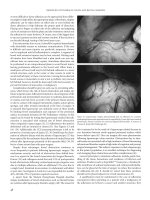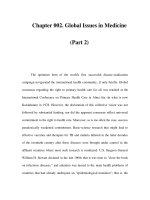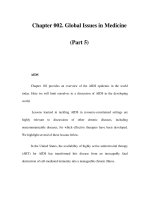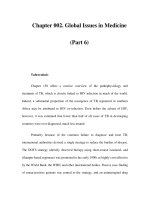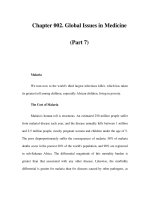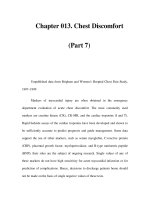100 Questions in Cardiology - Part 7 pps
Bạn đang xem bản rút gọn của tài liệu. Xem và tải ngay bản đầy đủ của tài liệu tại đây (115.34 KB, 24 trang )
33
New York Heart Association class III or IV
44
Non-transplant cardiac surgery considered unfeasible
5
5
Heart failure resulting from one of the following:
• Ischaemic heart disease
• Cardiomyopathy
• Valvular heart disease
• Congenital heart disease.
Lung transplantation – indications
11
Severe respiratory failure, despite maximal medical therapy
22
Severely impaired quality of life
3
3
Patient positively wants a transplant.
Only patients who have deteriorating chronic respiratory
failure should be accepted on to the transplant waiting list. In
practice, the forced expiratory volume in one second is usually
less than 30% of the predicted value.
Careful psychological assessment is necessary to exclude
patients with intractable psychosocial instability that may
interfere with their ability to cope with the operation and to
comply with the strict post operative follow up and immuno-
suppressive regimes. In most centres, the upper age limit is 60
years for cardiac transplantation and for single lung transplantation
and 50 years for heart-lung and bilateral lung transplantation.
Contraindications for cardiac and lung transplantation
11
Psychosocial instability and poor compliance
22
Infection with hepatitis B or C virus or with human immuno-
deficiency virus
3
3
Active mycobacterial or aspergillus infection
44
Active malignancy (patient must be in complete remission for
more than five years after treatment)
5
5
Active peptic ulceration
66
Severe osteoporosis
77
Other end-organ failure not amenable to transplantation e.g.
hepatic failure or renal failure (creatinine clearance <50mls/min).
Incremental risk factors for pulmonary transplantation include
previous thoracic surgery and pleurodesis and patients are not
accepted on to the waiting list who are on long term prednisolone
126 100 Questions in Cardiology
therapy in excess of 10mg/d. Additional contraindications for
cardiac transplantation include pulmonary vascular resistance
greater than 3 Wood units and severe lung disease.
FFuurrtthheerr rreeaaddiinngg
Madden B. Lung transplantation. In: Hodson MR, Geddes DM, eds. Cystic
fibrosis. London: Chapman & Hall, 1994: 329–46.
Madden B, Geddes D. Which patients should receive lung transplants?
Monaldi Arch Chest Dis 1993;
4
488::
346–52.
Murday AJ, Madden BP. Surgery for heart and lung failure. Surgery
1996;
1144
: 18–24
100 Questions in Cardiology 127
60 What are the survival figures for heart and
heart-lung transplantation?
Brendan Madden
In the International Registry for Heart and Lung Transplantation,
the one year actuarial survival following cardiac transplantation
is approximately 80%. Thereafter there is an annual attrition rate
of 2 to 4% so that five year actuarial survival and ten year actuarial
survival is approximately 65% and 50% respectively. One and
three year actuarial survival following heart-lung and bilateral
lung transplantation is approximately 70% and 50% respectively
and approximately 80% and 60% respectively following single
lung transplantation. Most survivors demonstrate a marked
improvement in quality of life. Lung function increases rapidly
following surgery and forced expiratory volume in one second
and forced vital capacity are usually in excess of 70% by the end
of the third postoperative month. Results of living related lobar
transplantation are similar to those for heart-lung and bilateral
lung transplantation.
The most serious late complication following cardiac trans-
plantation is transplant associated coronary artery disease and
following pulmonary transplantation is obliterative bronchiolitis.
FFuurrtthheerr rreeaaddiinngg
Madden B, Hodson M, Tsang V et al. Intermediate term results of heart-
lung transplantation for cystic fibrosis. Lancet 1992;
333399
: 1583–7.
Madden B, Radley-Smith R, Hodson M et al. Medium term results of
heart and lung transplantation. J Heart Lung Transplant 1992;
1
111
: S241–3.
Murday AJ, Madden BP. Surgery for heart and lung failure. Surgery
1996;
1144
: 18–24.
128 100 Questions in Cardiology
61 What drugs do post-transplant patients require,
and what are their side effects? How should I
follow up such patients?
Brendan Madden
Following successful cardiac, cardiopulmonary or pulmonary
transplantation, patients require life-long immunosuppressive
therapy. Routine immunosuppression consists of cyclosporin-A
and azathioprine, occasionally supplemented by cortico-
steroids. Episodes of acute allograft rejection are treated with
intravenous methylprednisolone therapy or occasionally anti-
thymocyte globulin or OKT3. Other drugs used include
tacrolimus, mycophenolate mofetil and cyclophosphamide.
Early evidence suggests that mycophenolate mofetil (an
antimetabolite drug) may be a useful alternative to azathioprine
as maintenance postoperative immunosuppression. OKT3 is a
monoclonal antibody raised in mice, which is directed against
the lymphocyte CD3 complex. Although it is sometimes used
for induction following transplantation it is now more
frequently employed in the management of severe episodes of
acute cardiac rejection.
Common complications following transplantation include
allograft rejection and infection. It is of paramount importance to
immunosuppress the patient to minimise the risk of allograft
rejection, without over-immunosuppressing and thereby
increasing susceptibility to opportunistic infection. For this
reason, cyclosporin-A blood levels are regularly monitored post-
operatively. Side effects include renal failure, hypertension,
hyperkalaemia, hirsutism, gum hypertrophy and increased
susceptibility to opportunistic infection and to lympho-
proliferative disorders. Tacrolimus acts in a similar way to
cyclosporin-A although it may be a more potent immunosup-
pressive agent. Although its side effect profile is similar, diabetes
mellitus can be a complication. Azathioprine is an antimetabolite
whose major side effects include bone marrow suppression and
hepatic cholestasis. Occasionally pancreatitis can occur. Some
patients who are intolerant of azathioprine are prescribed
mycophenolate mofetil (which is less likely to cause bone
marrow suppression) or cyclophosphamide. At the present time
the precise role of tacrolimus and mycophenolate in post-cardiac
100 Questions in Cardiology 129
and pulmonary transplant immunosuppression is unclear and
requires further study. The side effect profile of corticosteroid
therapy is well documented.
In addition to regular monitoring of drug levels and haemato-
logical (full blood count) and biochemical (renal and hepatic
function, blood glucose) indices, one should be aware of drug
interactions which may reduce or increase the levels or
effectiveness of immunosuppressive agents. For example drugs
which promote hepatic enzyme induction (e.g. anticonvulsants,
antituberculous therapy) will reduce cyclosporin-A levels.
Certain antibiotics (e.g. erythromycin) and calcium channel
blockers (e.g. diltiazem) will increase cyclosporin-A levels.
Similar interactions apply to tacrolimus. Non-steroidal anti-
inflammatory agents can potentiate nephrotoxicity when given
with cyclosporin-A or tacrolimus. The dose of azathioprine has to
be reduced by 70% if patients are also prescribed allopurinol.
FFuurrtthheerr rreeaaddiinngg
Madden B. Late complications following cardiac transplantation. Br Heart J
1994;
7722
: 89–91.
Madden B, Kamalvand K, Chan CM et al. The medical management of
patients with cystic fibrosis following heart-lung transplantation. Eur
Resp J 1993;
6
6
: 965–70.
Madden BP. Immunocompromise and opportunistic infection in organ
transplantation. Surgery 1998;
1166::
37–40.
130 100 Questions in Cardiology
62 Can a cardiac transplant patient get angina?
How is this investigated?
Brendan Madden
Post-transplant cardiac denervation theoretically abolishes the
perception of cardiac chest pain. However, some patients may
develop postoperative typical anginal chest pain precipitated by
exercise or by increasing heart rate. This has been associated with
ECG evidence of ischaemia and coronary angiography has
confirmed transplant associated coronary artery disease. Such
symptoms, however, are usually described by patients who are
more than five years following transplantation. Chest pain
associated with coronary artery disease is uncommon in patients
who are less than five years post-cardiac transplantation.
Interestingly, recent evidence shows an absence of bradycardic
response to apnoea and hypoxia in cardiac transplant recipients
with obstructive sleep apnoea. It may be that prospective
overnight polysomnography studies will identify parasympa-
thetic re-innervation in this group.
The majority of patients with transplant associated coronary
artery disease do not get chest pain. Presenting features include
progressive dyspnoea with exertion or the signs and symptoms of
cardiac failure. Cardiac auscultation may reveal a third or fourth
heart sound or features of heart failure. The ECG may show
rhythm disturbances or a reduction in total voltage (the
summation of the R and S wave in leads I, II, III, V1 and V6).
Transthoracic 2D echocardiography may reveal evidence of poor
biventricular function. Most units do not advocate routine annual
coronary angiography for asymptomatic patients, since the angio-
graphic findings do not usually alter clinical managment.
Furthermore, conventional coronary angiography does not always
confirm the diagnosis; intravascular ultrasound may be more
sensitive. The condition is frequently diffuse and distal and not
usually amenable to intervention, e.g. with angioplasty, stent
insertion or bypass surgery. In those patients who have a localised
lesion, the disease may progress despite successful intervention.
The majority of centres do not usually offer cardiac re-transplan-
tation on account of shortage of donor organs and poor results
attendant on cardiac re-transplantation. Therefore patients who
develop this condition are usually managed medically.
100 Questions in Cardiology 131
FFuurrtthheerr rreeaaddiinngg
Grant SCD, Brooks NH. Accelerated graft atherosclerosis after heart
transplantation. Br Heart J 1993;
6699
: 469–70.
Madden B, Shenoy V, Dalrymple-Hay M et al. Absence of bradycardic
response to apnoea and hypoxia in cardiac transplant recipients with
obstructive sleep apnoea. J Heart Lung Transplant 1997;
1
166
: 394–7.
Mann J. Graft vascular disease in heart transplant patients. Br Heart J
1992;
6688
: 253–4.
132 100 Questions in Cardiology
63 What drugs should be used to maintain
someone in sinus rhythm who has paroxysmal
atrial fibrillation? Is there a role for digoxin?
Suzanna Hardman and Martin Cowie
The natural history of patients with paroxysmal atrial fibrillation
is that over a period of time (and often many years) there is a
gradual tendency to an increased frequency and duration of
attacks. A proportion of patients will develop chronic atrial
fibrillation. Not all patients require antiarrhythmic drugs and the
potential side effects and inconvenience of regular medication
must be balanced against the frequency of episodes and
symptomatology which vary markedly between patients.
Triggers include alcohol and caffeine, ischaemia, untreated
hypertension (which if aggressively managed can at least in the
short term obviate the need for antiarrhythmics), thyrotoxicosis,
and in a small proportion of patients vagal or sympathetic stimu-
lation where attacks are typically preceded by a drop in heart rate
or exercise respectively.
The most effective drugs are also those with potentially
dangerous side effects. The risks of class 1 agents (such as
flecainide, disopyramide and propafenone) in patients with
underlying coronary artery disease are well recognised and are
best avoided. In younger patients (where it is presumed the
associated risks are proportionately less) they can be highly
effective. Sotalol may be useful in some patients but adequate
dosing is required to achieve class 3 antiarrhythmic activity and
not all patients will tolerate the associated degree of beta
blockade. Amiodarone can be highly effective but its use is
limited by the incidence of serious side effects. Beta blockers and
calcium channel blockers have no role in preventing paroxysms
of atrial fibrillation but can help certain patients in reducing the
rate and so symptomatology.
Despite the long-standing conviction of many clinicians that
digoxin is efficacious in the management of paroxysmal atrial
fibrillation it has been clearly shown that digoxin neither reduces
the frequency of attacks nor produces any useful reduction of
heart rate during paroxysms of atrial fibrillation. Furthermore a
number of placebo-controlled studies designed to explore the
possibility that digoxin might chemically cardiovert patients
100 Questions in Cardiology 133
with recent onset atrial fibrillation have shown no effect of
digoxin as compared with placebo. Hence there appears to be no
role for digoxin.
FFuurrtthheerr rreeaaddiinngg
Falk RH, Knowlton AA, Bernard SA et al. Digoxin for converting recent-
onset atrial fibrillation to sinus rhythm. Ann Intern Med 1987;
110066
: 503–6.
Jordaens L, Trouerbach PC, Tavernier R et al. Conversion of atrial
fibrillation to sinus rhythm and rate control by digoxin in comparison to
placebo. Eur Heart J 1997;
1
188
: 643–8.
Rawles JM, Metcalfe MJ, Jennings K. Time of occurrence, duration, and
ventricular rate of paroxysmal atrial fibrillation: the effect of digoxin. Br
Heart J 1990;
6633
: 224–7.
134 100 Questions in Cardiology
64 Which patients with paroxysmal or chronic
atrial fibrillation should I treat with aspirin,
warfarin or neither?
Suzanna Hardman and Martin Cowie
Patients in whom the risk of thromboembolism is considered to
be greater than the risk of a serious bleed due to warfarin should
be considered for formal anticoagulation. In published clinical
trials of anticoagulation the risk of stroke was reduced from 4.3%
per year to 1.3% per year with anticoagulation. This equates to 30
strokes prevented for 1000 patients treated with warfarin for 12
months. Whether such benefit can be seen in routine practice
depends not only on a careful decision for each patient regarding
the risk of bleeding and the risk of thromboembolism, but also on
the quality of monitoring the intensity of anticoagulation. The
usual practice is to anticoagulate to a target INR of 2.5 (range 2–3),
unless there is a history of recurrent thromboemboli in which
case higher intensity anticoagulation may be necessary. In the
clinical trials the risk of serious bleeding was 0.9% per year in the
control group and slightly higher (1.3%) in those on warfarin.
Risk factors for bleeding on anticoagulants include serious co-
morbid disease (such as anaemia, renal, cerebrovascular or liver
disease), previous gastrointestinal bleeding, erratic or excessive
alcohol misuse, uncontrolled hypertension, immobility, and poor
quality clinical and anticoagulant monitoring.
Aspirin therapy is often recommended for elderly patients with
atrial fibrillation on the basis that there is a lower risk of bleeding
compared with warfarin. The likely benefits of aspirin are also
less than those of warfarin. Further, the bulk of AF-associated
stroke occurs in those aged >75 years, and the benefits of anti-
coagulation are not outweighed by the risks in high-risk elderly
patients in whom monitoring is carefully carried out.
1
Where
warfarin is genuinely considered unsuitable (or is unacceptable
to a patient), and the patient is at significant risk of thrombo-
embolism, there is evidence that aspirin at a dose of 325mg per
day reduces the risk of thromboembolism, but no evidence that
lower doses are effective. The combination of fixed-dose low
intensity warfarin with aspirin confers no benefit over conven-
tional warfarin therapy in terms of bleeding risks and is less
effective in preventing thromboembolism.
100 Questions in Cardiology 135
RReeffeerreenncceess
1 Hart RG. Warfarin in atrial fibrillation: underused in the elderly, often
inappropriately used in the young. Heart 1999;
8822
: 539–40.
FFuurrtthheerr rreeaaddiinngg
Stroke Prevention in Atrial Fibrillation Investigators. Adjusted dose
warfarin versus low-intensity, fixed dose warfarin plus aspirin for
high-risk patients with atrial fibrillation: stroke prevention in atrial
fibrillation III. Lancet 1996;
3
34488
: 633–8.
Stroke Prevention In Atrial Fibrillation Investigators. Stroke Prevention
in Atrial Fibrillation Study. Final results. Circulation 1991;
8844
: 527–39.
Hardman SM, Cowie M. Fortnightly review(:) anticoagulation in heart
disease. BMJ: 1999;
331188
: 238–44 (website version at www.bmj.com).
Petersen P, Botsen G, Godfredsen J et al. Placebo-controlled, randomised
trial for prevention of thromboembolic complications in chronic atrial
fibrillation. The Copenhagen AFASAK Study. Lancet 1989;
i
i
: 175–9.
136 100 Questions in Cardiology
65 Which patients with SVT should be referred for
an intracardiac electrophysiological study (EP
study)? What are the success rates and risks of
radiofrequency (RF) ablation?
Roy M John
The management of supraventricular tachycardia (SVT) has
changed dramatically with the development of curative radiofre-
quency ablation (RF ablation). For most patients, the technique
offers a clear alternative to long term antiarrhythmic drug therapy
with its potential toxic side effects. Except for atrial fibrillation
and atypical atrial flutter, most SVTs are amenable to RF ablation
albeit with some variation in success rates depending on the
arrhythmia mechanism.
AV nodal re-entrant tachycardia and SVTs mediated via
accessory pathways are the easiest to treat with RF ablation with
success rates that exceed 90%.
1
Recurrence is rare occurring in less
than 10%. Focal atrial tachycardias and re-entrant atrial tachy-
cardias resulting from prior atrial surgical scars have lower success
rates of about 80%. Even for the rare but troublesome atrial tachy-
cardia that cannot be ablated, RF ablation of the AV node with
permanent cardiac pacing is effective in alleviating symptoms and
can reverse any tachycardia mediated cardiomyopathy. Atrial
flutter of the classical variety use a single re-entrant circuit in the
right atrium and typically require an isthmus of tissue between the
inferior vena cava and tricuspid valve for maintenance of the
arrhythmia. RF ablation to create conduction block in this isthmus
is effective in preventing recurrence of atrial flutter in 80% of
patients with negligible risks. Unfortunately some patients
develop atrial fibrillation because both arrhythmias share common
cardiac disease processes that act as substrates for the arrhythmia
mechanism. Nonetheless, fibrillation is easier to manage with
drugs and combination of flutter ablation and antiarrhythmic drug
therapy is often successful in maintaining sinus rhythm.
In the adult patient with the symptomatic Wolff Parkinson
White syndrome, it is now generally believed that RF ablation
should be the treatment of choice. Recurrent arrhythmias
associated with ventricular pre-excitation are difficult to treat
medically and often require the use of antiarrhythmic drugs with
potent pro-arrhythmic effects or organ toxicity (e.g. flecainide,
100 Questions in Cardiology 137
amiodarone). The risk of AV block is remote (less than 1%) unless
the accessory pathway is located close to the AV node in which
case the risk is higher. In infants and young children, on the other
hand, it is often worth deferring RF ablation if possible because
there is a chance that ventricular pre-excitation may resolve over a
few years.
In contrast to the above, arrhythmias such as AV nodal re-
entrant tachycardia often respond to acute or interval therapy
with one of the more benign AV nodal blocking agents e.g.
digoxin, beta blockers or calcium blocker. RF ablation should
therefore be reserved for recurrent or troublesome arrhythmia.
Situations that justify earlier RF ablative therapy include haemo-
dynamic instability during episodes, intolerance of drugs, desire
to avoid long term drug therapy or occupational constraints such
as in airline pilots. It is also worth bearing in mind that once a
patient requires more than two drugs for prophylaxis, it becomes
more cost effective to proceed to RF ablation. The risk of AV block
during RF ablation for AV nodal re-entrant tachycardia is
between 1 and 2%,
2
and is dependent on the experience of the
operator. In the younger patients, even this low rate of compli-
cation can be important considering life time commitment to
cardiac pacing in the event of heart block.
The risk of RF ablation is primarily that of AV block as noted
above. Other risks are those related to cardiac catheterisation
and include vascular damage, cardiac tamponade, myocardial
infarction, cerebrovascular or pulmonary embolism and rarely
damage to the valve in left sided pathways. In experienced
centres, the risk of serious complications is less than 1%.
RReeffeerreenncceess
1 Ganz LI, Friedman PL. Medical progress: supraventricular tachycardia.
N Engl J Med 1995;
333322
: 162–73.
2 Kay GN, Epstein AE, Dailey SM et al. Role of radiofrequency ablation
in the management of supraventricular arrhythmias: experience in 760
consecutive patients. J Cardiovasc Electrophysiol 1993;
4
4
: 371–89.
138 100 Questions in Cardiology
66 What drugs should I use for chemically
cardioverting atrial fibrillation and when is DC
cardioversion preferable?
Suzanna Hardman and Martin Cowie
Drugs are more likely to be effective when used relatively early
following the onset of atrial fibrillation. However, when a clear
history of recent onset atrial fibrillation has been obtained it is
important to establish and treat the likely precipitants. In many
instances this will allow spontaneous reversion to sinus
rhythm. Important precipitants include hypoxia, dehydration,
hypokalaemia, hypertension, thyrotoxicosis and coronary
ischaemia. Whilst these precipitants are being treated rate
control will usually be required. Short acting oral calcium
channel blockers (verapamil or diltiazem) and short acting beta
blockers titrated against the patients response are most effective
in this setting and likely to facilitate cardioversion. Intravenous
verapamil should be avoided. If a patient with new atrial
fibrillation is haemodynamically compromised urgent
cardioversion is required with full heparinisation. Similarly
patients with fast, recent onset atrial fibrillation with broad
complexes are probably best treated with early elective DC
cardioversion with full heparinisation.
With the above provisos there is a role for chemical
cardioversion. Amiodarone (which has class III action and mild
beta blocking activity) given through a large peripheral line or
centrally can be highly effective, though a rate slowing agent may
also be needed. Intravenous flecainide (class I) can also be highly
effective. Like other class I agents (quinidine, disopyramide and
procainamide), flecainide is best avoided in patients with known
or possible coronary artery disease and in conditions known to
predispose to torsade de pointes. Digoxin has no role in the
cardioversion of atrial fibrillation.
The highest likelihood of successful cardioversion in patients
with chronic atrial fibrillation is with DC cardioversion
following appropriate investigation and anticoagulation. It
should be noted that cardioversion is generally safe during
digoxin therapy, so long as potassium and digoxin levels are in
the normal range.
100 Questions in Cardiology 139
FFuurrtthheerr rreeaaddiinngg
Falk RH. Proarrhythmic responses to atrial antiarrhythmic therapy. In:
Falk RH, Podrid PJ, eds. Atrial fibrillation mechanisms and management, 2nd
edition. Philadelphia: Lippincott and Raven, 1997: 371–379.
Janse MJ, Allessie MA. Experimental observations on atrial fibrillation.
In: Falk RH, Podrid PJ, eds. Atrial fibrillation mechanisms and management.
2nd edition. Philadelphia: Lippincott and Raven, 1997: 53–73.
Nattel S, Courtemarche, Wang Z. Functional and ionic mechanisms of
antiarrhythmic drugs in atrial fibrillation. In: Falk RH, Podrid PJ, eds.
Atrial fibrillation mechanisms and management, 2nd edition. Philadelphia:
Lippincott and Raven, 1997: 75–90.
140 100 Questions in Cardiology
67 How long should someone with atrial
fibrillation be anticoagulated before DC
cardioversion, and how long should this be
continued afterwards?
Suzanna Hardman and Martin Cowie
For years, the rationale for a period of anticoagulation prior to
cardioversion was that the anticoagulation would either stabilise
or abolish any thrombus, the assumption being that thrombo-
emboli associated with cardioversion occurred when effective
atrial contraction was restored, dislodging pre-existing thrombus.
Furthermore, it was assumed that recent onset atrial fibrillation
was not associated with left atrial (LA) or left atrial appendage
(LAA) thrombus and could therefore be safely cardioverted
without anticoagulation. Although this has become standard
clinical practice it is not evidence-based and not without hazard.
With anticoagulation most thrombus appears to resolve rather
than to organise. In patients with non-rheumatic atrial fibrillation
most atrial thrombi will have resolved after four to six weeks of
anticoagulation but persistent thrombus has been reported. Left
atrial thrombus is present in a significant proportion of patients
with recent onset atrial fibrillation and the associated thrombo-
embolic rate is similar to that found in patients with chronic atrial
fibrillation. Furthermore, cardioversion itself is associated with
the development of spontaneous contrast and new thrombus and,
in the absence of anticoagulation, even those patients who have
had thrombus excluded using transoesophageal echocardiography
have subsequently developed symptomatic thromboemboli.
For most patients a period of 4 to 6 weeks of anticoagulation
and a transthoracic echocardiogram prior to cardioversion will be
sufficient. Patients at high risk of thrombus (e.g. those with
cardiomyopathy, mitral stenosis or previous thromboembolism)
should undergo a transoesophageal study prior to cardioversion.
In certain patients there may be cogent arguments for minimising
the period of anticoagulation. In these patients transoesophageal
echocardiography can be undertaken and provided no thrombus
is identified will abolish the need for prolonged anticoagulation
prior to cardioversion. However, all patients with atrial
fibrillation need to be fully anticoagulated at the time of
cardioversion and for a period thereafter.
100 Questions in Cardiology 141
The duration of post-cardioversion anticoagulation should be
dictated by the likely timing of the return of normal LA/LAA
function and the likelihood of maintaining sinus rhythm. If atrial
fibrillation has been present for several days only, normal atrial
function will usually be re-established over a similar period and
intravenous heparin for a few days post-cardioversion is probably
adequate. Where the duration of AF is longer or unknown a period
of anticoagulation with warfarin for 1–3 months is advised
(reflecting a slower time course of recovery of atrial function).
FFuurrtthheerr rreeaaddiinngg
Black IW, Fatkin D, Sagar KB et al. Exclusion of atrial thrombus by trans-
oesoophageal echocardiography does not preclude embolism after
cardioversion of atrial fibrillation. A multicenter study. Circulation
1994;
8
899
: 2509–13.
Hardman SM, Cowie M. Fortnightly review: anticoagulation in heart
disease. BMJ 1999;
331188
: 238–44 (website version at www.bmj.com).
Stoddard MF, Dawkins PR, Prince CR et al. Left atrial appendage
thrombus is not uncommon in patients with acute atrial fibrillation and a
recent embolic event; a transoesophageal echocardiographic study. J Am
Coll Cardiol 1995;
2
255
: 452–9.
142 100 Questions in Cardiology
68 What factors determine the chances of
successful elective cardioversion from atrial
fibrillation?
Suzanna Hardman and Martin Cowie
Elective cardioversion should only be undertaken when the
precipitant (e.g. hypoxia, ischaemia, thyrotoxicosis, hypokalaemia
and hypoglycaemia) has been treated and the patient is
metabolically stable. With this proviso, the success of
cardioversion depends not so much on the ability to restore sinus
rhythm (success rates of 70–90% are usual), but rather on the
capacity to sustain sinus rhythm.
Cardioversion of unselected patients will result in consistently
high rates of relapse: at one year 40 to 80% of patients will have
reverted to atrial fibrillation. Early cardioversion, particularly in
those patients in whom a clear trigger of atrial fibrillation has been
effectively treated and in whom there is little or no evidence of
concomitant cardiac disease, is associated with the best long term
outcome. This may reflect the finding (well described in animal
models) that sustained atrial fibrillation modifies atrial electro-
physiology so that, with time, there is a predisposition to continued
and recurrent AF. If early cardioversion is not feasible, then the
extent of underlying cardiac disease may be a more important
determinant of long term outcome than the duration of AF.
The presence of severe structural cardiac disease is associated
with a high relapse rate and sometimes an inability to achieve
cardioversion, e.g. severe ventricular dysfunction, markedly
enlarged atria and valvular disease.
Certain categories of patients justify specific mention:
• Obese patients may be especially resistant to cardioversion
from the external route but not necessarily using electrodes
positioned within the heart.
• A proportion of patients with paroxysmal atrial fibrillation
will eventually develop chronic atrial fibrillation: for many
this provides a paradoxical reprieve from their symptoms. If
cardioverted their propensity to atrial fibrillation remains and
they are likely to relapse.
• The prognosis of patients with structurally normal hearts who
develop atrial fibrillation as a result of thyrotoxicosis is
100 Questions in Cardiology 143
excellent: once the thyrotoxicosis has been treated a high
proportion revert to sinus rhythm and the remainder are
sensitive to cardioversion with a relatively low relapse.
FFuurrtthheerr rreeaaddiinngg
Hardman SMC. Ventricular function in atrial fibrillation. In: Falk RH,
Podrid PJ, eds. Atrial fibrillation mechanisms and management, 2nd edition.
Philadelphia: Lippincott and Raven, 1997: 91–108.
Nakazawa H, Lythall DA, Noh J et al. Is there a place for the late
cardioversion of atrial fibrillation? A long-term follow-up study of patients
with post-thyrotoxic atrial fibrillation. Eur Heart J;
2
211
: 327–333.
Van Gelder IC, Crijns HJ, Van Gilst WH et al. Prediction of uneventful
cardioversion and maintenance of sinus rhythm from direct current
electrical cardioversion of chronic atrial fibrillation and flutter. Am J
Cardiol 1991;
6
688
: 41–6.
Wijffels MCEF, Kirchhof CJHJ, Dorland R et al. Atrial fibrillation begets
atrial fibrillation. A study in awake chronically instrumented goats.
Circulation 1995;
9922
: 1954–68.
144 100 Questions in Cardiology
69 What are the risks of elective DC cardioversion
from atrial fibrillation?
Suzanna Hardman and Martin Cowie
There are relatively few recent published data on the risks of
elective DC cardioversion. The risks include those relating to an,
albeit brief, general anaesthetic which will reflect the overall
health of the patient, and those relating to the application of
synchronised direct current shock. The latter include the
development of bradyarrhythmias (more likely in the presence of
heavy beta blockade and especially where there is concomitant
use of calcium channel antagonists) and tachyarrhythmias (more
likely in the presence of deranged biochemistry including low
serum K
+
or Mg
++
, and high levels of serum digoxin). These
dysrhythmias may necessitate emergency pacing or further
cardioversion and full resuscitation. Elective cardioversion of
adequately assessed patients should only be undertaken by
appropriately trained staff in an area where full resuscitation
facilities are available. Following cardioversion high quality
nursing care and ECG monitoring will be required until the
patient has recovered from the anaesthetic and is clinically stable.
Failure to observe these guidelines will likely result in higher
complication rates which on occasion includes death.
The other major complication of DC cardioversion is
thromboembolism which can be debilitating and is sometimes
fatal. There have been no randomised trials of anticoagulation
but there is convincing circumstantial evidence that anti-
coagulation reduces the risk of cardioversion-related thrombo-
embolism from figures in the order of 7% to less than 1%:
anticoagulation does not appear to abolish the risk and this
should be made explicit when informed consent is obtained
from a patient. Patients with recent onset AF are not devoid of
the risks of cardioversion-related thromboembolism and also
require anticoagulation.
FFuurrtthheerr rreeaaddiinngg
Bjerkelund CJ, Orning OM. The efficacy of anticoagulant therapy in
preventing embolism related to DC electrical cardioversion of atrial
fibrillation. Am J Cardiol 1969;
2233
: 208–16.
100 Questions in Cardiology 145
Schnittger I. Value of transoesophageal echocardiography before DC
cardioversion in patients with atrial fibrillation: assessment of embolic
risk. Br Heart J 1995;
7733
: 306–9.
Yurchack PM, for Task Force Members: Williams SV, Achford JL,
Reynolds WA et al. AHA/ACC/ACP Task Force statement. Clinical
competence in elective direct current (DC) cardioversion. Circulation
1993;
8
888
: 342–5.
146 100 Questions in Cardiology
70 Are patients with atrial flutter at risk of
embolisation when cardioverted? Do they need
anticoagulation to cover the procedure?
Suzanna Hardman and Martin Cowie
Although common clinical practice and guidelines do not
advocate routine anticoagulation of patients with atrial flutter
undergoing cardioversion, there are no data to support this
practice. Rather, recent studies suggest the prevalence of intra-
atrial thrombus in unselected patients with atrial flutter is
significant and of the order of 30–35% (compared with 3% preva-
lence in a control population in sinus rhythm). The atrial stand-
still (or stunning) that has been described post-cardioversion of
atrial fibrillation and is thought to be a factor in the associated
thromboembolic risk has also now been described immediately
post-cardioversion of patients with atrial flutter. Although some
authors argue that the stunning post-cardioversion of atrial flutter
is “attenuated” compared with the response in atrial fibrillation,
the thromboembolic rate associated with cardioversion of atrial
flutter in the absence of anticoagulation argues against this.
Indeed, the thromboembolic rate appears to be comparable with
the early experience of cardioverting atrial fibrillation.
Furthermore, atrial flutter is an intrinsically unstable rhythm
which may degenerate into atrial fibrillation and certain patients
alternate between atrial fibrillation and atrial flutter.
Like atrial fibrillation, atrial flutter may be the first manifestation
of underlying heart disease and it is likely, though not yet proven,
that the thromboembolic risks associated with both chronic atrial
flutter and with cardioversion of atrial flutter vary with the extent of
underlying cardiovascular pathology. Although existing data are
limited, on current evidence we advise that patients with atrial
flutter should be anticoagulated prior to, during and post-
cardioversion, in the same way as patients with atrial fibrillation.
FFuurrtthheerr rreeaaddiinngg
Bikkina M, Alpert MA, Madhuri M et al. Prevalence of intra-atrial
thrombus in patients with atrial flutter. Am J Cardiol 1995;
7766
;186–9.
Irani WN, Grayburn PA, Afrii I. Prevalence of thrombus, spontaneous
echo contrast, and atrial stunning in patients undergoing cardioversion
100 Questions in Cardiology 147
of atrial flutter. A prospective study using transoesophageal echo-
cardiography. Circulation 1997;
9955
: 962–6.
Jordaens L, Missault L, Germonpre E et al. Delayed restoration of atrial
function after cardioversion of atrial flutter by pacing or electrical
cardioversion. Am J Cardiol 1993;
7
711
: 63–6.
Mehta D, Baruch L. Thromboembolism following cardioversion of
common atrial flutter. Risk factors and limitations of transoesophageal
echocardiography. Chest 1996;
111100
: 1001–3.
148 100 Questions in Cardiology
71 How do I assess the risk of CVA or TIA in a
patient with chronic atrial fibrillation and in a
patient with paroxysmal atrial fibrillation?
Suzanna Hardman and Martin Cowie
Age is an important determinant of the risk of thrombo-
embolism, and hence of transient ischaemic attack (TIA) and of
cerebrovascular accident (CVA) in patients with atrial
fibrillation. If the patient is aged less than 60 years, and has no
evidence of other cardiac disease (such as coronary artery
disease, valve disease or heart failure) the risk of thrombo-
embolism is low (of the order of 0.5% per year). This risk is lower
than the risk of a serious bleed if the patient is anticoagulated
with warfarin (1.3% per year or higher depending on the quality
of anticoagulation control). If the patient is older than the 60
years, or has evidence of other cardiovascular disease, the risk of
thromboembolism increases.
In the Stroke Prevention in Atrial Fibrillation Study clinical
features indicating a higher risk of thromboembolism were: age
over 60 years; history of congestive heart failure within the
previous 3 months; hypertension (treated or untreated); and
previous thromboembolism. The more of these features present in
a patient the higher the risk of thromboembolism. A large left
atrium (>2.5cm diameter/m
2
body surface area) or global left
ventricular systolic dysfunction on transthoracic echo-
cardiography also identifies patients at a higher risk of thrombo-
embolism. Such abnormalities may not be suspected clinically
and wherever possible echocardiography should be performed in
patients with AF in order to determine more precisely the risk of
thromboembolism.
Paroxysmal (as opposed to chronic) atrial fibrillation covers a
wide spectrum of disease severity with the duration and
frequency of attacks varying markedly between and within
patients. Although the clinical trials of anticoagulation in patients
with atrial fibrillation were inconsistent in including patients
with paroxysmal atrial fibrillation, there was no evidence that
such patients had a lower risk of thromboembolism than those
with chronic atrial fibrillation. It is likely that as the episodes
become more frequent and of longer duration that the risk
approaches those in patients with chronic atrial fibrillation.
100 Questions in Cardiology 149


